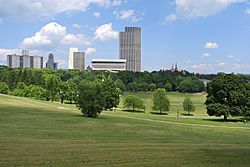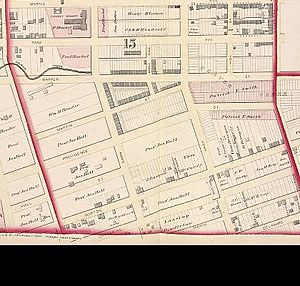Lincoln Park (Albany, New York) facts for kids
Quick facts for kids Lincoln Park |
|
|---|---|

Empire State Plaza seen from the south side of Lincoln Park
|
|
| Lua error in Module:Location_map at line 420: attempt to index field 'wikibase' (a nil value). | |
| Type | Urban park |
| Location | Albany, New York |
| Area | 68 acres (28 ha) |
| Created | 1900 |
| Operated by | City of Albany |
| Status | |
|
Lincoln Park
|
|
| NRHP reference No. | 100000890 |
| Added to NRHP | February 20, 2018 |
Lincoln Park is a cool city park in Albany, New York. It has a really interesting past! Long ago, it was a place where the Dutch and Mohawks had a fight. Later, it became home to brick factories and breweries. It even had Albany's very first public playground!
Today, Lincoln Park is a great spot for fun. It has Albany's only outdoor swimming pool (not a shallow wading pool!). You can also find tennis courts, basketball courts, and fields for football and baseball. Inside the park, there's the James Hall Office, which is a special historic building. There's also an elementary school called the Thomas O'Brien Academy of Science and Technology (TOAST).
In 2018, Lincoln Park was added to the National Register of Historic Places. This means it's recognized as an important historical place.
Contents
Park History
Lincoln Park is mostly in a big valley. This valley was carved out by a stream called the Beaver Kill. This stream used to flow from the west all the way to the Hudson River.
Early Days and Mills
In 1626, something important happened here. The leader of the Dutch Republic's outpost, Fort Orange, went with his soldiers. They were helping their friends, the Mohicans, fight against the Mohawks. They were surprised near what is now Delaware Avenue. The Dutch leader and three soldiers died in this battle.
As Albany grew, the land and the stream (called a "kill" in Dutch) became owned by the Dutch Reformed Church. A man named Evert Wendell built sawmills, gristmills, and a brewery here before 1737. He used the water power from the stream. These buildings were near where the Lincoln Park swimming pool is today. By 1800, the mills were old and not used anymore. Later, about 40 acres (16 ha) of land were sold for pasture.
Brick Factories and Breweries
The land around the Beaver Kill had lots of good clay. Because of this, several brickyards opened in Lincoln Park during the 1800s. Most of them were along Morton Avenue.
The Beaver Kill also had a natural waterfall. This waterfall was west of Park Avenue and South Swan Street. It provided power for local businesses. Many breweries were built around the falls. They dumped so much waste into the stream that the waterfall became known as Buttermilk Falls!
Albany's First Playground
The southwestern part of the park used to belong to James Hall. He was a scientist who had an office built around 1852. He also had a house built around 1880 near Delaware Avenue.
The first part of Lincoln Park to open was a children's playground. It was built by the Mother's Club, which is now the Women's Club of Albany. This playground included James Hall's land. It was Albany's first park that was more than just a quiet place. It was the city's first public playground and was called the Central Playground. James Hall's office became a place for indoor activities for kids. The spot where his house stood is now where the tennis courts are.
Developing the Park
West of Hawk Street, there was once a small town called Martinville. It was an Irish settlement from the time of the US Civil War.
In 1890, officials were allowed to buy land for Beaver Park. This area was most of what is now Lincoln Park, east of Swan Street. Plans for the park were drawn up in 1914. The original idea was very grand, but what was built was simpler. Still, the basic plan for sports fields, a swimming pool, and children's activities was kept.
These changes in the early 1900s included tearing down Martinville in 1910. A swimming pool was built in 1915, but it got dirty because a sewer (the underground Beaver Creek) was too close. So, the current swimming pool was built in its place in 1930.
School and Civic Center Ideas
In 1954, Albany Public School 24 (PS 24) was built in the northwestern part of the park. In 1990, the school was renamed the Thomas O'Brien Academy of Science and Technology (TOAST).
In the 1980s, there were ideas to build a big civic center in the eastern part of Lincoln Park. A civic center is a large building for events and meetings. The mayor at the time, Mayor Erastus Corning 2nd, was interested. However, the civic center was eventually built somewhere else in Downtown Albany. Today, it's called the Times Union Center.
Recent Changes
In 1989, a famous bike race called the Tour de Trump had a loop through Lincoln Park.
In 1993, South Swan Street inside the park was renamed Dr. Martin Luther King Jr. Boulevard. A statue of Martin Luther King Jr. was put up at the corner of this boulevard and Morton Avenue. Martin Luther King III, his son, was there for the unveiling. The statue is 8 feet (2.4 m) tall. It has granite panels with pictures from his life and lines from his speeches.
The building next to the Lincoln Park pool was updated in 2001. This renovation cost $3 million.
Images for kids
-
Lincoln Park as seen from the Corning Tower of the Empire State Plaza.



